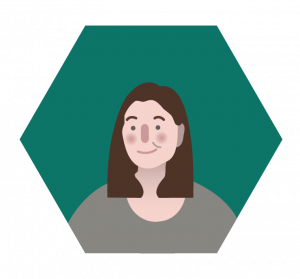20 We’re Total Pro
Professional Learning
Professional Learning. Or “I’ve Just Done a Bunch of Learning and Want a Plan to Learn More”
by Alana Callan, Fleming College
The Open Faculty Patchbook was stitched together to provide you with a manual of sage advice from folks that have walked a mile or two shoes just like yours.
As you reflect on the chapters that were masterfully written and curated, hopefully you have highlighted the parts that stood out for you. Maybe you’ve ‘written in the margins’ with your own thoughts and questions. Maybe you have felt a connection with your cohort of post-secondary professionals that have shared their experience and wisdom intentionally to get you started on your journey. Our hope is that you will use it as a resource as you move forward with your own teaching and learning and reach out to folks as you refine your teaching practice.
How you want to proceed with your own professional learning journey is completely up to you. There are lots of formal and informal options available to you.
In order to help you get started, thought I would share a little of my own journey.
Fleming College has been talking about learning and what it means for the past 50 years. For me personally, it hasn’t been nearly that long, although I have spent the better part of my adult life here at Fleming College. Once upon a time, waaaaay back in 2009, I made some deliberate steps to get completely out of my comfort zone and to take control of my own professional learning. I decided to go back to school to complete my Bachelor of Education for Adult Learners. At Fleming, I had been working directly with faculty and staff to support their learning goals in developing online courses, integrating technology into their teaching practice and helping folks gain confidence in their technical skills.
I was working directly with adults, so I was very motivated to spend some time earning a credential to match. At the same time the use of social media had become more mainstream. For me, if CBC News was using hashtags and twitter to deliver news then I had to start to embrace social media as well.
I had already started with Facebook as a way to keep in touch with friends and family, but I was quickly hearing about the collaboration opportunities that using technology and social media afforded. Twitter and other collaborative technology provided a way for connecting people so that they were able to learn together, openly.
While taking formal courses in the fall of 2009, I also registered as a non-credit student in an open course offered through the University of Regina. I had found out about the course and how I could participate in it for free for through twitter. FOR FREE? WHAT?:)
Alec Couros was the professor and the course was called ‘Social Media and Open Education‘ it was a Masters level course offered for credit for 20 students registered through the University of Regina and also had over 100 students ‘registered’ as non-credit students who were interested in learning and participating together. It was one of the first MOOCs (In 2008 George Siemens and Stephen Downes offered CCK08 MOOC – so they deserve the full credit – this MOOC was offered based on their research which lead to acknowledging the growing new learning theory of Connectivism.) I had no idea at the time that I was experiencing the tip of the iceberg!!
Those two experiences really began to shape my understanding of professional learning and the importance of making connections and understanding how I really learn… weird, huh?
Since then, I have come to see connections between learning and Design Thinking along with Universal Design for Learning, and empathy for how we each differ in how and when we learn.
Connectivism and Constructivism as learning theories appealed to the ‘teacher’ in me, and design thinking gave me a process to use in order to plan and design my learning, and my opportunities for learning with others (formal and informal). Also, Universal Design for Learning (UDL) provided me with the framework to use my design thinking process and associate it with pedagogy.
WHAT DOES THIS MEAN EXACTLY?
Good Question! My hope is that you (dear reader) may use this as a way to focus your own professional learning. Design Thinking methodology has several steps that, when related to teaching, can be boiled down to:
- Discover
- Define
- Develop
- Deliver
When you compare those 4 steps to Universal Design for Learning (UDL), you’ll find that there is definitely some synergy:
- Instructional Goals (Define)
- Assessments (Evaluate – part of the Deliver stage)
- Method (Develop)
- Materials (Discover)
HOW CAN YOU USE THESE STEPS TO DEFINE YOUR OWN PROFESSIONAL LEARNING?
Even better question! Enjoy learning informally… it really is fun!! But when you need to learn with a specific goal in mind be sure to:
- Set clear and obtainable goals and objectives – just like you do with your students (Instructional Goals)
- Critically review the resources (Materials) that you will use. Look for open resources that will connect you with the connectors that will help move (or push) you to advance your learning by constructing new knowledge
- Develop (or create) your content, diagrams, maps, presentations (Materials) that showcase your learning (write a blog and publish it openly.)
- License your work/picture/presentation to be reused for attribution so that your learning can be built upon
- Evaluate your learning and refine it as necessary, seek feedback from other (local and online peers)
Most importantly, share your work. You’ll find that sharing and seeking feedback provides you with the next part of your plan and the next path you’ll take on your professional learning journey.
I wanted to end with a couple of easy ways to learn something new everyday (or whenever)
- Follow hashtags of interest to you on twitter and other social media (#edtech, #opened, #digped, etc.,) you don’t have to have a twitter account to do this but it definitely helps!!! Don’t know what a hashtag is, check this out. Know what a hashtag is and want to have a laugh? Check out “#Hashtag” with Jimmy Fallon & Justin Timberlake (Late Night with Jimmy Fallon)
- Use a reader app on your phone, tablet or computer. Check your app store for a variety of apps. I am currently using Feedly and have it organized based my interests. Not sure what app to try? Check out https://www.digitaltrends.com/android/best-read-it-later-apps/
- Talk to colleagues, share your questions and what you are learning. You’d be surprised at what you get in return. You literally have online or f2f cohort or collective at your finger tips via this patchbook.
- Check out our ‘preview patch’ for a future patchbook focused on professional learning (It’s the next chapter). In it, Autumm Caines of Capital University in Columbus, Ohio describes how to use synchronous video effectively in your professional learning escapades.
RESOURCES:
I’ve included some links in the text of this patch and wanted to include some articles that I read to help inform and inspire me.
- Designing a Functional Learning Community – David Ng
- Professional Learning Framework for the Teaching Profession – Ontario College of Teachers
- How we approach professional learning at Slack (which is also a cool collaborative tool)
- Find your tribe: a spectrum of engagement and professional learning – Megan Allen Center for Teaching Quality
- Universal Design? Really? Debbie Donsky EdD

featured image: “BMX Fly 2” flickr photo by DAV.eshttps://flickr.com/photos/despedidairene/6155777470 shared under a Creative Commons (BY) license


